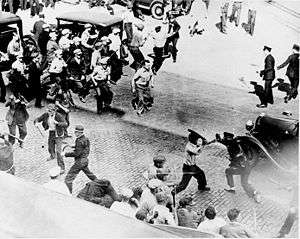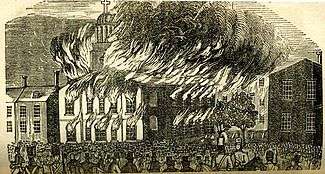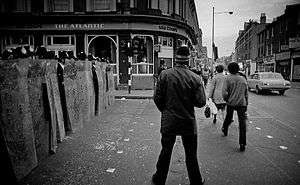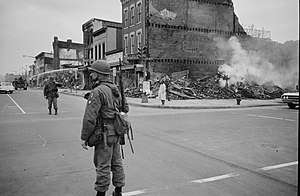Riot
A riot (/ˈraɪət/) is a form of civil disorder commonly characterized by a group lashing out in a violent public disturbance against authority, property or people.



Riots typically involve destruction of property, public or private. The property targeted varies depending on the riot and the inclinations of those involved. Targets can include shops, cars, restaurants, state-owned institutions, and religious buildings.[1]
Riots often occur in reaction to a grievance or out of dissent. Historically, riots have occurred due to poverty, unemployment, poor living conditions, governmental oppression, taxation or conscription, conflicts between ethnic groups (race riot) or religions (sectarian violence, pogrom), the outcome of a sporting event (sports riot, football hooliganism) or frustration with legal channels through which to air grievances.[2]
While individuals may attempt to lead or control a riot, riots typically consist of disorganized groups that are frequently "chaotic and exhibit herd behavior."[1] There is a growing body of evidence to suggest that riots are not irrational, herd-like behavior (sometimes called mob mentality), but actually follow inverted social norms.[3]
Dealing with riots is often a difficult task for police forces. They may use tear gas or CS gas to control rioters. Riot police may use less-than-lethal methods of control, such as shotguns that fire flexible baton rounds to injure or otherwise incapacitate rioters for easier arrest.[4]
Classification

Food riots are caused by harvest failures, incompetent food storage, hoarding, poisoning of food, or attacks by pests like locusts. When the public becomes desperate from such conditions, groups may attack shops, farms, homes, or government buildings to obtain bread or other staple foods like grain or salt. T. S. Ashton, in his study of food riots among colliers, noted that "the turbulence of the colliers is, of course, to be accounted for by something more elementary than politics: it was the instinctive reaction of virility to hunger."[5] Charles Wilson noted, "Spasmodic rises in food prices provoked keelmen on the Tyne to riot in 1709, tin miners to plunder granaries at Falmouth in 1727."[6] In the 1977 Egyptian Bread Riots, hundreds of thousands of people rioted after food subsidies stopped and prices rose.[7]
A police riot is a term for the disproportionate and unlawful use of force by a group of police against a group of civilians. This term is commonly used to describe a police attack on civilians, or provoking civilians into violence.
A prison riot is a large-scale, temporary act of concerted defiance or disorder by a group of prisoners against prison administrators, prison officers, or other groups of prisoners. It is often done to express a grievance, force change or attempt escape.
In a race riot, race or ethnicity is the key factor. The term had entered the English language in the United States by the 1890s. Early use of the term referred to riots that were often a mob action by members of a majority racial group against people of other perceived races.
In a religious riot, the key factor is religion. The rioting mob targets people and properties of a specific religion, or those believed to belong to that religion.[8]
Sports riots such as the Nika riots can be sparked by the losing or winning of a specific team or athlete. Fans of the two teams may also fight. Sports riots may happen as a result of teams contending for a championship, a long series of matches, or scores that are close. Sports are the most common cause of riots in the United States, accompanying more than half of all championship games or series. Almost all sports riots occur in the winning team's city.[9]
Student riots are riots precipitated by students, often in higher education, such as a college or university. Student riots in the US and Western Europe in the 1960s and the 1970s were often political in nature. Student riots may also occur as a result of oppression of peaceful demonstration or after sporting events. Students may constitute an active political force in a given country. Such riots may occur in the context of wider political or social grievances.
Urban riots are riots in the context of urban decay, provoked by conditions such as discrimination, poverty, high unemployment, poor schooling, poor healthcare, housing inadequacy and police brutality and bias. Urban riots are closely associated with race riots and police riots.
Effects

The economic and political effects of riots can be as complex as their origins. Property destruction and harm to individuals are often immediately measurable. During the 1992 Los Angeles riots, 2,383 people were injured, more than 12,000 were arrested, 63 people were killed and over 700 businesses burned. Property damage was estimated at over $1 billion. At least ten of those killed were shot by police or National Guard forces.[10]
Similarly, the 2005 civil unrest in France lasted over three weeks and spread to nearly 300 towns. By the end of the incident, over 10,000 vehicles were destroyed and over 300 buildings burned. Over 2,800 suspected rioters were arrested and 126 police and firefighters were injured. Estimated damages were over €200 Million.
Riot control and laws
.jpg)
Riots are typically dealt with by the police, although methods differ from country to country. Tactics and weapons used can include attack dogs, water cannons, plastic bullets, rubber bullets, pepper spray, flexible baton rounds, and snatch squads. Many police forces have dedicated divisions to deal with public order situations. Some examples are the Territorial Support Group (London), Special Patrol Group (London), Compagnies Républicaines de Sécurité (France), Mobiele Eenheid (Netherlands), and Arrest units (Germany).

The policing of riots has been marred by incidents in which police have been accused of provoking rioting or crowd violence. While the weapons described above are officially designated as non-lethal, a number of people have died or been injured as a result of their use. For example, seventeen deaths were caused by rubber bullets in Northern Ireland over the thirty five years between 1970 and 2005.[11]
Risk of arrest
A high risk of being arrested is even more effective against rioting than severe punishments.[12] As more and more people join the riot, the risk of being arrested goes down, which persuades still more people to join. This leads to a vicious cycle, which is typically ended only by sufficient police or military presence to increase the risk of being arrested.[12]
National laws
India
In India, rioting[13] is an offense under the Indian Penal Code (IPC).
United Kingdom
England and Wales

Riot is a statutory offence in England and Wales. It is created by section 1(1) of the Public Order Act 1986. Sections 1(1) to (5) of that Act read:
- (1) Where 12 or more persons who are present together use or threaten unlawful violence for a common purpose and the conduct of them (taken together) is such as would cause a person of reasonable firmness present at the scene to fear for his personal safety, each of the persons using unlawful violence for the common purpose is guilty of riot.
- (2) It is immaterial whether or not the 12 or more use or threaten unlawful violence simultaneously.
- (3) The common purpose may be inferred from conduct.
- (4) No person of reasonable firmness need actually be, or be likely to be, present at the scene.
- (5) Riot may be committed in private as well as in public places.
A single person can be liable for an offence of riot when they use violence, provided that it is shown there were at least twelve present using or threatening unlawful violence.
The word "violence" is defined by section 8. The violence can be against the person or against property. The mens rea is defined by section 6(1).
Indictment
See R v Tyler and others, 96 Cr App R 332, [1993] Crim LR 60, CA.
Mode of trial and sentence
Riot is an indictable-only offence. A person convicted of riot is liable to imprisonment for any term not exceeding ten years, or to a fine, or to both.[14]
See the following cases:
- R v Luttman [1973] Crim LR 127, CA
- R v Pilgrim, 5 Cr App R (S) 140, CA
- R v Keys, 84 Cr App R 204, 8 Cr App R (S) 444, [1987] Crim LR 207, CA
- R v Cooke, 9 Cr App R (S) 116, CA
Association football matches
In the case of riot connected to football hooliganism, the offender may be banned from football grounds for a set or indeterminate period of time and may be required to surrender their passport to the police for a period of time in the event of a club or international match, or international tournament, connected with the offence. This prevents travelling to the match or tournament in question. (The measures were brought in by the Football (Disorder) Act 2000 after rioting of England fans at Euro 2000.[15])
Compensation for riot damage
See the Riot (Damages) Act 1886 and section 235 of the Merchant Shipping Act 1995..
Construction of "riot" and cognate expressions in other instruments
Section 10 of the Public Order Act 1986 now provides:
- (1) In the Riot (Damages) Act 1886 . . . (compensation for riot damage) "riotous" and "riotously" shall be construed in accordance with section 1 above.
- (2) In Schedule 1 to the Marine Insurance Act 1906 (form and rules for the construction of certain insurance policies) "rioters" in rule 8 and "riot" in rule 10 shall, in the application of the rules to any policy taking effect on or after the coming into force of this section, be construed in accordance with section 1 above unless a different intention appears.
- (3) "Riot" and cognate expressions in any enactment in force before the coming into force of this section (other than the enactments mentioned in subsections (1) and (2) above) shall be construed in accordance with section 1 above if they would have been construed in accordance with the common law offence of riot apart from this Part.
- (4) Subject to subsections (1) to (3) above and unless a different intention appears, nothing in this Part affects the meaning of "riot" or any cognate expression in any enactment in force, or other instrument taking effect, before the coming into force of this section.[16]
As to this provision, see pages 84 and 85 of the Law Commission's report.[17]
Common law offence
The common law offence of riot was abolished[18] for England and Wales[19] on 1 April 1987.[20]
History
In the past, the Riot Act had to be read by an official - with the wording exactly correct - before violent policing action could take place. If the group did not disperse after the Act was read, lethal force could legally be used against the crowd. See also the Black Act.
Section 515 of the Merchant Shipping Act 1894 formerly made provision for compensation for riot damage.
Northern Ireland
Riot is a serious offence for the purposes of Chapter 3 of the Criminal Justice (Northern Ireland) Order 2008.[21]
See paragraph 13 of Schedule 5 to the Electoral Law Act (Northern Ireland) 1962.
Scotland
There is an offence under the law of Scotland which is known both as "mobbing" and "mobbing and rioting".
In July 1981, both Dundee and Edinburgh saw significant disorder as part of the events of that July,[22][23][24] while in 1994[25] and in 2013,[26] two years after the English riots of August 2011, Edinburgh saw rioting, albeit localised to one specific area and not part of any bigger 'riot wave'. Events in 1981 were very similar to those in England, although sources are severely limited. Both Niddrie and Craigmillar saw riots in the 1980s.[27]
United States

Under United States federal law, a riot is defined as:
A public disturbance involving (1) an act or acts of violence by one or more persons part of an assemblage of three or more persons, which act or acts shall constitute a clear and present danger of, or shall result in, damage or injury to the property of any other person or to the person of any other individual or (2) a threat or threats of the commission of an act or acts of violence by one or more persons part of an assemblage of three or more persons having, individually or collectively, the ability of immediate execution of such threat or threats, where the performance of the threatened act or acts of violence would constitute a clear and present danger of, or would result in, damage or injury to the property of any other person or to the person of any other individual.18 U.S.C. § 2102.
Each state may have its own definition of a riot. In New York, the term riot is not defined explicitly, but under § 240.08 of the N.Y. Penal Law, "A person is guilty of inciting to riot when one urges ten or more persons to engage in tumultuous and violent conduct of a kind likely to create public alarm."
See also
|
|
References
- Braha, D. (2012). "Global Civil Unrest: Contagion, Self-Organization, and Prediction". PLOS ONE. 7 (10): e48596. Bibcode:2012PLoSO...748596B. doi:10.1371/journal.pone.0048596. PMC 3485346. PMID 23119067.
- Smead, Howard; Tager, Jack (December 2001). "Boston Riots: Three Centuries of Social Violence". The New England Quarterly. 74 (4): 669. doi:10.2307/3185445. ISSN 0028-4866. JSTOR 3185445.
- "You won't prevent future riots by disregarding the psychology of crowds". The Guardian. Aug 19, 2011.
- Davison, Neil (2009), "The Early History of 'Non-Lethal' Weapons", 'Non-Lethal' Weapons, Palgrave Macmillan UK, pp. 12–39, doi:10.1057/9780230233980_2, ISBN 978-1-349-30656-5
- Ashton, T. S., and Joseph Sykes. 1967. The Coal Industry of the Eighteenth Century. 2d ed. New York: A. M. Kelley. p. 131.
- E.P. Thompson (Feb 1971). "The Moral Economy of the English Crowd in the Eighteenth Century". Past and Present. 50 (50): 77. doi:10.1093/past/50.1.76. JSTOR 650244.
- Patel, Raj; McMichael, Philip (2014), "A Political Economy of the Food Riot", Riot, Unrest and Protest on the Global Stage, Palgrave Macmillan UK, pp. 237–261, doi:10.1007/978-1-137-30553-4_13, ISBN 978-1-137-30552-7
- "Thrown pig leads to religious riots in India". CNN. July 3, 2009. Retrieved May 22, 2010.
- Ballard, Steve (2011-12-26). "The Kiss". Sports Illustrated. Retrieved December 24, 2011.
- Jim Crogan (Apr 24, 2002). "The L.A. 53". LA Weekly.
- Williams, Anthony G. "Less-lethal ammunition". Archived from the original on 2009-09-03.
an amended version of an article which first appeared in Jane's Police Products Review, October/November 2007, and includes information from British 37mm Baton Rounds, which appeared in Small Arms Review in August 2008
- How Riots Start, and How They Can Be Stopped: Edward Glaeser, Edward Glaeser, Bloomberg.com, Aug 12, 2011
- "Offences related to Rioting in Indian Penal Code".
- The Public Order Act 1986, section 1(6)
- "Explanatory Notes to the Football (Disorder) Act 2000". Legislation.gov.uk. 2013-02-26. Retrieved 2013-04-30.
- Digitized copy
- The Law Commission. Criminal Law: Offences relating to Public Order (Law Com 123). HMSO. 1983.
- The Public Order Act 1986, section 9(1)
- The Public Order Act 1986, section 42
- The Public Order Act 1986 (Commencement No. 2) Order 1987, article 2 and Schedule (1987/198 (C. 4))
- The Criminal Justice (Northern Ireland) Order 2008, article 12(2) and Schedule 1, paragraph 4.
- "The Riot Experts". The New York Times. The New York Times, July 14, 1981. 1981-07-14. Retrieved 2015-04-02.
- "Police report flare-ups Police at Dundee, The Kokomo Tribune". newspapers.com The Kokomo Tribune from Kokomo, Indiana · Page 1 July 13, 1981. Retrieved 2015-04-02.
- "The Architecture of Servitude and Boredom, Russell Kirk" (PDF). Retrieved 2015-03-04.
- ""eh16" - The Craigmillar Riots of 1994". Retrieved 2015-04-03.
- "Police braced for further rioting in Edinburgh after patrol cars are petrol bombed, Daily Record, 10 July 2013". 2013-07-10. Retrieved 2014-03-04.
- "Unregarded Edinburgh, Niddrie Old Police Station". 2012-11-13. Retrieved 2015-04-03.
Sources:
- Blackstone's Police Manual. Volume 4, "General police duties". Fraser Simpson (2006). p. 245. Oxford University Press. ISBN 0-19-928522-5.
Further reading
- Applegate, Col. Rex (1992). Riot Control: Materiel and Techniques. Paladin Press. ISBN 978-0-87364-208-8.
- Beene, Capt. Charles (2006). Riot Prevention and Control: A Police Officer's Guide to Managing Violent and Nonviolent Crowds. Paladin Press. ISBN 1-58160-518-8.
- Bessel, Richard; Emsley, Clive (2000). Patterns of Provocation: Police and Public Disorder. Berghahn Books. ISBN 1-57181-228-8.
- Bloome, Clive (2003). Violent London: 2000 Years of Riots, Rebels and Revolts. London: Sidgwick & Jackson. ISBN 0-283-07310-1.
- Clover, Joshua (2016). Riot: The New Era of Uprisings. London: Verso. ISBN 978-1-78478-059-3.
- Hernon, Ian (2006). Riot!: Civil Insurrection from Peterloo to the Present Day. Pluto Press. ISBN 0-7453-2538-6.
- Nagl, Dominik (2013). No Part of the Mother Country, but Distinct Dominions - Rechtstransfer, Staatsbildung und Governance in England, Massachusetts und South Carolina, 1630–1769. LIT. ISBN 978-3-643-11817-2. Online pp. 594
- Waddington, P. A. J. (1991). The Strong Arm of the Law: Armed and Public Order Policing. Clarendon Press. ISBN 0-19-827359-2.
- The Black Bloc Papers: An Anthology of Primary Texts From The North American Anarchist Black Bloc 1988-2005 (PDF), by Xavier Massot & David Van Deusen of the Green Mountain Anarchist Collective (NEFAC-VT), Breaking Glass Press, 2010.
External links
| Wikiquote has quotations related to: Riot |
![]()